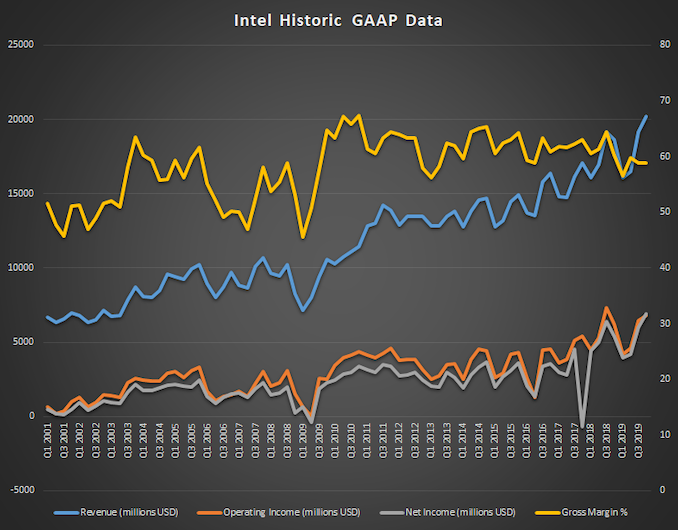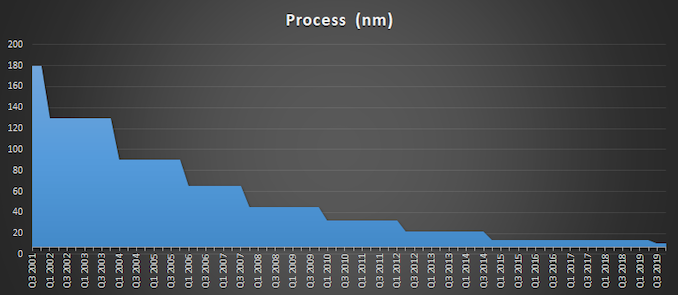Intel Q4 FY 2019 Results: Record Quarter, Record Year
by Brett Howse on January 23, 2020 8:45 PM EST- Posted in
- CPUs
- Intel
- Financial Results

Today Intel announced their earnings for the fourth quarter of their 2019 fiscal year. In terms of revenue, Intel had their highest ever Q4 revenue, coming in at $20.2 billion, and the full 2019 fiscal year, which was $72 billion. On a year-over-year basis, the results were up 8% and 2% respectively. Intel’s margins did slip a bit though, falling 1.4% to 58.8% of revenue. Operating income for the quarter was $6.8 billion, up 9% from last year, and net income was up 33% to $6.9 billion. This resulted in earnings-per-share of $1.58, up 40% from a year ago.
| Intel Q4 2019 Financial Results (GAAP) | |||||
| Q4'2019 | Q3'2019 | Q4'2018 | |||
| Revenue | $20.2B | $19.2B | $18.7B | ||
| Operating Income | $6.8B | $6.4B | $6.2B | ||
| Net Income | $6.9B | $6.0B | $5.2B | ||
| Gross Margin | 58.8% | 58.9% | 60.2% | ||
| Client Computing Group Revenue | $10.0B | +3% | +2% | ||
| Data Center Group Revenue | $7.2B | +12% | +19% | ||
| Internet of Things Revenue | $1.16B | +16% | +16% | ||
| Mobileye Revenue | $229M | +14% | +20% | ||
| Non-Volatile Memory Solutions Group | $1.2B | -7.7% | +10% | ||
| Programmable Solutions Group | $505M | flat | -17% | ||
Intel’s Client Computing Group, or CCG, had revenues of $10.0 billion for the quarter, up 2% from a year ago. Intel attributes the growth to modem sales and desktop platform volume. Intel is of course moving out of the 5G modem business, but will maintain its other connectivity offerings in the CCG such as their Wi-Fi products. Notebook platform volumes were down 1% in this quarter, with average selling prices staying flat, but desktop platform volumes were up 7%, but average selling prices fell 4%. Intel has said that they are expecting their chip shortage to be over by the end of this fiscal year.
Intel’s Data Center Group had revenue of $7.2 billion, up 19% from a year ago. Data Center sold 12% more unit volume this quarter than Q4 2018, and also added in 5% more average selling price per unit, so Intel’s DCG group is still very healthy.
Internet of Things, which include Mobileye, achieved revenue of $1.16 billion, up from $999 million a year ago. IoT was up 13%, accounting for $920 million of that revenue, and Mobileye was up 31% to $240 million.
Non-volatile Storage had revenue of $1.2 billion for the quarter, up 10% from a year ago which Intel is attributing to both NAND and Optane bit growth.
Programable Storage was the one area where Intel had a revenue drop, falling 17% year-over-year to $505 million, with no explanation given, but clearly FPGAs were in shorter demand.
Looking ahead to Q1 2020, Intel is expecting approximately $19.0 billion in revenue for the quarter, with earnings-per-share of $1.23.
Source: Intel Investor Relations












67 Comments
View All Comments
Makaveli - Friday, January 24, 2020 - link
anecdotal evidence doesn't really mean anything.I still have an Socket 939 AMD Opteron system that still runs fine to this day and is stable.
alufan - Friday, January 24, 2020 - link
not intel anyway, intel has a great marketing team and in the early days they just threw money at oems and system builder until they were caught and fined, those old school buyers are now end of career in many cases and new younger buyers are starting to change the landscape, look again this time next year.in 2016 A?MD had 16% of the market in Q3 2019 they had 32% and Ryzen (see what i did there)
anyway competition is good for us all but intel has been well and truly facepalmed and AMD will be making hay especially now they hjave the 4000 series mobile cpus out
wilsonkf - Monday, January 27, 2020 - link
Are you talking about CPU or GPU?Intel GPU ... issue free? serious?
yetanotherhuman - Friday, January 24, 2020 - link
I like GM and recently built an AMD system. It's like a mirror.Makaveli - Friday, January 24, 2020 - link
If you haven't built an AMD system in 10 years what your posting isn't really relevant for today is it?Beaver M. - Friday, January 24, 2020 - link
Yeah well, same with me, and even almost 20 years ago, when the AMD hype was as big as it is now. I was completely disappointed with all the issues of AMD CPU *and* GPUs.But shouldnt the have improved a lot by now? Especially since the last console generation was all AMD. Compatibility shouldnt be an issue anymore. But as you I havent tried it yet. And I still hesitate, even though I could use a new PC (still running 4 cores). Fanboys are silent about such problems. I remember when I mentioned mine in forums. I was bashed into a red pulp for daring to mention it.
Beaver M. - Friday, January 24, 2020 - link
GPUs being ATI, sorry.Makaveli - Friday, January 24, 2020 - link
So your opinion is based on products from 20 years ago?Beaver M. - Friday, January 24, 2020 - link
I am just saying that it was that bad that it still holds me back nowadays, because I know how fanboys silence critics, like youre trying to do right now.Korguz - Friday, January 24, 2020 - link
he does have a point.. i have both system sill in use now.. and just built a new ryzen comp a few weeks ago for a friend.. the board didnt support ryzen 3k out of the box ( older bios ) messaged amd.. they sent me a 1st gen apu so i could update the bios, for free.. set the system up with the ryzen 3k.. no issues at all. works great.. the friend is veey happy with it..